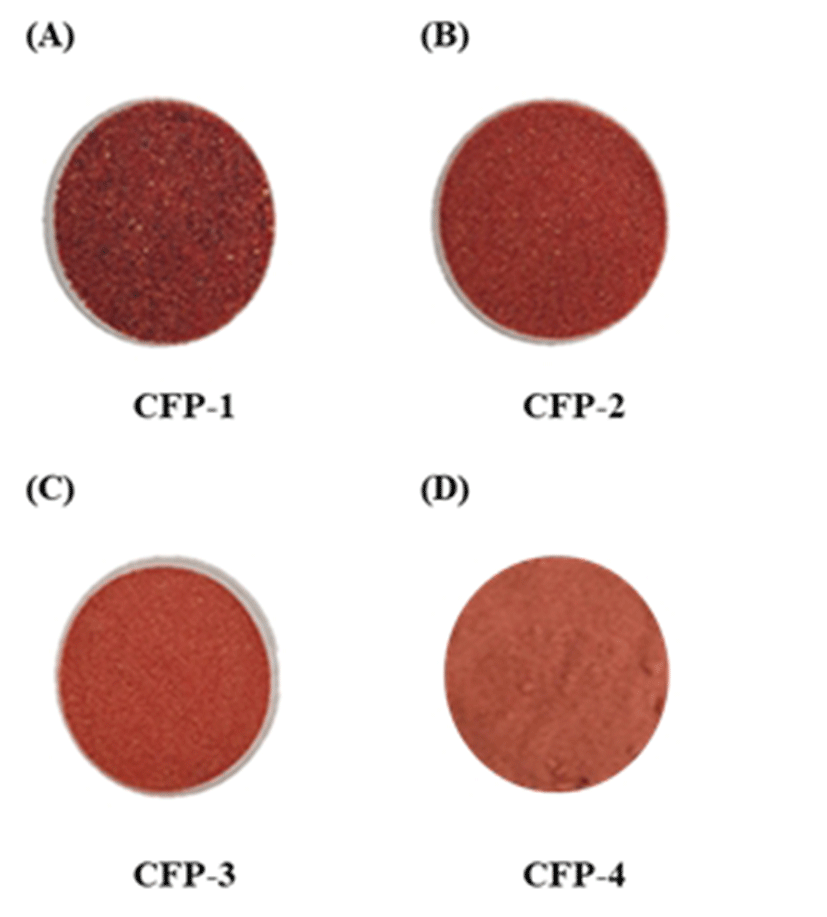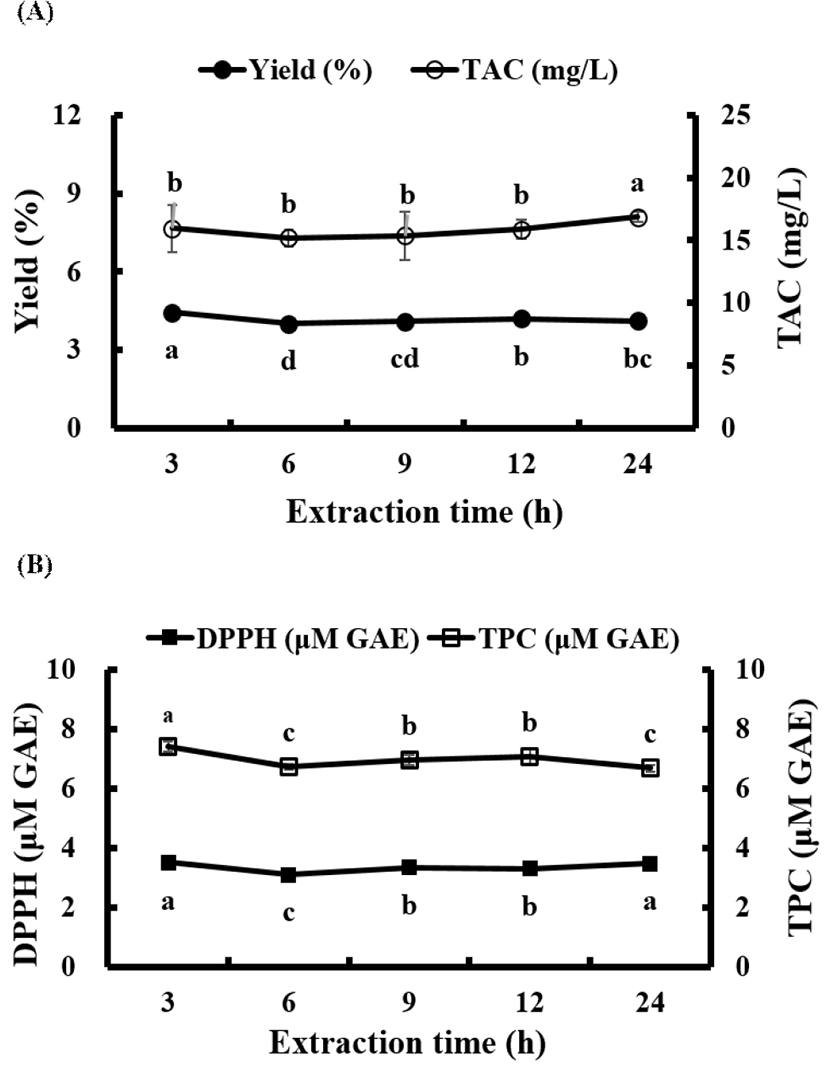서론
산수유(Cornus officinalis)는 층층나무과에 속하는 약용식물로서 내한성이 강하고 음지에서도 개화 할 수 있을 정도로 이식력이 강하며, 겨울에 꽃봉오리가 피기 시작하여 3, 4월에 노란 꽃이 만개한다(1). 산수유 열매(Corni Fructus)는 1.5 cm 이내의 장추원형의 모양으로 늦은 가을과 초겨울에 붉은색을 띠며, 종자에는 렉틴이라는 독성이 있어 제핵 후 과실을 건조시켜 주로 약용으로 이용되어 왔다(2). 산수유 열매의 주요 성분으로는 안토시아닌(anthocyanin), 우르솔산(ursolic acid), 주석산(tartaric acid), 사과산(malic acid) 외에 모로니사이드(morroniside), 로가닌(loganin), 스웨로사이드(sweroside), 메틸 모로니사이드(methyl morroniside) 등의 배당체가 있으며(3) 항당뇨(4), 기억력 증진(5), 산화적 스트레스에 의한 신경세포 독성을 예방하는 효능이 있는 것으로 알려져 있다(6). 식물성 시료는 유기용매(물, 에탄올, 메탄올)로 추출 하였을 때, 안토시아닌(anthocyanin), 탄닌(tannin), 폴리페놀(polyphenol)등의 성분이 주로 추출되며, 비극성 용매(헥산, 에테르, 클로로포름)로 추출 하였을 때는 테르펜노이드(terpenoids), 플라보노이드(flavonoids)등의 성분이 추출된다(7). 산수유 열매의 물 추출물은 항히스타민, 항아세틸콜린 및 항바륨작용, 황색포도상구균을 억제하며, 메탄올 추출물과 에틸분획물은 피부질환 치료제 및 미백효과에 대한 연구가 보고되었고(8), 에탄올 추출물은 항알레르기, 여드름균 억제 등에 효능이 있다(9,10). 국내연구로는 산수유 추출물의 항균 및 항산화 활성(11), 함유된 항암물질의 정제 및 특성(12), 산수유의 유리자유기에 의한 간 손상 보호효과 및 기전에 대한 연구(13) 등이 있다.
본 연구에서는 산수유의 기능성 소재화에 필요한 적정 추출 조건을 구명하기 위하여 분말 입도, 추출 용매와 추출시간에 따른 색도와 항산화능을 조사하여 보고하는 바이다.
재료 및 방법
본 실험에 사용된 산수유(Corni Fructus)는 경북대학교 교내에서 채취하여 정선 및 수세 작업을 거쳐 물기를 제거 후 음지, 상온에서 자연건조 하였다(수분 함량 11%). 건조된 산수유를 막자사발로 마쇄하여 나온 산수유 분말(Corni Fructus powder, CFP)을 표준체(Chung Gye Industrial Co., Osan, Korea)를 이용하여 CFP-1(25-45 mesh), CFP-2 (45-60 mesh), CFP-3(60-100 mesh), CFP-4(>100 mesh)로 분류하였다(Fig. 1).

분말 입도에 따른 산수유의 추출 조건은 산수유 분말 CFP-1, CFP-2, CFP-3, 및 CFP-4 각각에 메탄올을 시료 무게의 10배에 해당하는 양을 가하여 12시간 정치추출 후 여과(Whatman No.2)하여 여액을 시액으로 사용하였다. 추출 용매에 따른 산수유의 추출 조건은 산수유 분말 CFP-2에 물, 30% 에탄올, 60% 에탄올, 90% 에탄올, 메탄올 추출 용매를 시료 무게 10배에 해당하는 양을 각각 가하여 12시간 정치추출 후 여과(Whatman No.2)하여 여액을 시액으로 사용하였다. 추출 시간에 따른 산수유의 추출 조건은 산수유 분말 CFP-2에 추출 용매 90% 에탄올을 시료 무게 10배에 해당하는 양을 가하여 추출 시간에 따라 3시간, 6시간, 9시간 12시간, 24시간 동안 각각 정치추출 후 여과(Whatman No.2)하여 여액을 시액으로 사용하였다.
추출 수율은 추출 조건에 따라 얻은 시액을 사용하였으며, 건조오븐을 이용하여 105℃ 상압가열건조법(14)으로 항량이 될 때까지 건조한 후 추출액 조제에 사용한 원료 건물량에 대한 고형분 수율(%)로 나타내었다.
산수유 분말 CFP-1, CFP-2, CFP-3 및 CFP-4의 시료 표면을 표준 백색판(L=99.50, a=-0.11, b=-0.13)으로 보정한 후 Hunter 색차계(CM-700d, Minolta Co., Osaka, Japan)를 이용하여 명도(L-value, lightness), 적색도(a-value, redness) 및 황색도(b-value, yellowness) 값을 10회 측정하여 나타내었다.
총 폴리페놀 함량은 Folin-Ciocalteu procedure(15)을 변형하여 측정하였다. 추출 조건에 따라 얻은 시액을 분석용 시료로 사용하였다. 분석용 시료 100 μL에 2 N Folin-Ciocalteu regent 50 μL와 20% sodium carbonate 300 μL를 가하여 실온에서 15분간 반응 후 증류수 1 mL를 가하여 원심분리(1,250 rpm, 5 min)하고 얻은 상등액을 725 nm에서 흡광도를 측정하였다. 총 폴리페놀 함량은 gallic acid를 이용하여 표준곡선을 작성하였으며 μM GAE로 나타내었다.
총 안토시아닌 함량은 pH differential 방법(16)을 이용하여 측정하였다. 추출 조건에 따라 얻은 시액을 분석용 시료로 사용하였다. 분석용 시료 0.5 mL에 0.025 M potassium chloride buffer(pH 1.0) 0.5 mL와 0.4 M sodium acetate buffer(pH 4.5) 0.5 mL를 각각 가하여 반응시킨 용액을 530 nm와 700 nm에서 각각의 흡광도를 측정하였으며, 아래 식에 따라 계산하여 나타내었다.
DPPH 라디칼 소거능은 Blois 등(17)의 방법을 변형한 방법으로 측정하였다. 추출 조건에 따라 얻은 시액을 분석용 시료로 사용하였다. 분석용 시료 20 μL과 200 μM DPPH 시액 180 μL를 혼합한 후 30분간 암실에서 방치하고 UV/Vis spectrometer(UV-1601, Shimadzu CO., Kyoto, Japan)를 이용하여 517 nm에서 측정하였다. DPPH 라디칼 소거능은 gallic acid를 이용하여 표준곡선을 작성하였으며 μM GAE로 나타내었다.
결과 및 고찰
분말 입도에 따른 산수유 시료는 Fig. 1에 나타냈으며, 색도 L 값(lightness), a 값(redness), b 값(yellowness)은 Table 1에 나타내었다. 산수유 분말 명도 L값은 CFP-4(47.29), CFP-3(36.68), CFP-2(35.57), CFP-1(32.53)로 분말 입도 크기가 작아질수록 명도 L 값이 증가하였다(p<0.05). 적색도 a 값은 CFP-2 시료가 30.71로 가장 높은 값을 나타냈으며, CFP-3(29.57), CFP-1(27.89), CFP-4(25.48) 순으로 나타났으며(p<0.05), Lee 등(18)의 연구에 따르면 분말의 적색도 a 값이 높을수록 안토시아닌 함량이 높다고 하였다. 황색도 b 값은 CFP-1(15.72), CFP-2(20.09), CFP-3(21.28) 순으로 분말 입도가 작아질수록 b 값이 증가하였으나, CFP-4는 17.91로 감소하였다(p<0.05). 분말 입도에 따라서 색도 L 값, a 값 및 b 값의 차이가 나타났으며, 적색도 a 값이 가장 높고 명도 L 값이 낮은 CFP-2 시료가 안토시아닌 함량도 높을 것으로 사료된다.
| CFP-11) | CFP-2 | CFP-3 | CFP-4 | |
|---|---|---|---|---|
| L2) | 32.53±0.54d3) | 35.57±0.02c | 36.68±0.09b | 47.29±0.02a |
| a | 27.89±0.01c | 30.71±0.01a | 29.57±0.02b | 25.48±0.01d |
| b | 15.72±0.01d | 20.09±0.02b | 21.28±0.02a | 17.91±0.01c |
분말 입도에 따른 산수유 시료 각각에 추출용매 메탄올을 시료 무게의 10배에 해당하는 양을 가하여 12시간 정치추출 하여 제조한 시액의 추출 수율 및 항산화능은 Table 2에 나타내었다. 분말 입도에 따른 추출 수율은 CFP-2 시료가 5.45%로 가장 높게 나타났으며, CFP-3(5.16%), CFP-4(4.97%), CFP-1(4.94%) 순으로 나타났다(p<0.05). 총 폴리페놀 함량은 2.53-3.55 μM GAE의 범위를 나타냈으며, CFP-2 및 CFP-4 시료에서 각각 3.52 μM GAE 및 3.55 μM GAE로 CFP-1(2.53 μM GAE)과 CFP-3(2.78 μM GAE)보다 높게 나타났다(p<0.05). 분말 입도가 가장 작은 CFP-4 시료는 분말 입도가 가장 큰 CFP-1 시료보다 총 폴리페놀 함량이 1.4배 높게 나타났으며, 감 껍질 분말의 입도가 작아질수록 총 폴리페놀 함량이 높아진다는 보고와 유사하였다(19). 총 안토시아닌 함량은 13.51-19.20 mg/L의 범위로 CFP-2 시료가 19.20 mg/L로 가장 높게 나타났으며, CFP-4(18.24 mg/L), CFP-3(15.53 mg/L), CFP-1(13.51 mg/L) 순으로 나타내었다(p<0.05). DPPH 라디칼 소거능은 1.49-2.14 μM GAE의 범위로 CFP-4의 시료가 2.14 μM GAE로 가장 높게 나타났으며, CFP-2(2.02 μM GAE), CFP-3(1.82 μM GAE), CFP-1(1.49 μM GAE) 순으로 나타내었다(p<0.05). 분말 입도별 추출 수율, 총 폴리페놀 함량, 총 안토시아닌 함량은 분말 입도 CFP-2에서 가장 높았고, DPPH 라디칼 소거활성도 높게 나타나 분말 입도 45-60 mesh(CFP-2)가 적합하다고 사료된다.
산수유 분말 입도 45-60 mesh(CFP-2)의 시료를 추출 용매에 따라 시료 무게의 10배에 해당하는 양을 가하여 12시간 정치 추출 하여 제조한 시액의 추출수율 및 항산화능을 Table 3에 나타내었다. 추출 용매에 따른 추출 수율은 60% 에탄올일 때 9.15%로 가장 높게 나타났으며, 90% 에탄올(7.95%), 30% 에탄올(7.61%), 메탄올(7.37%), 물(7.11%) 추출물 순으로 나타났다(p<0.05). 오미자를 추출 용매에 따라 추출 하였을 때 유기용매 추출물이 물 추출물 보다 수율이 높았으며(20), 본 연구의 결과와 유사 하였다. 총 폴리페놀 함량은 3.34-5.20 μM GAE의 범위로 30% 에탄올과 60% 에탄올이 각각 5.20 μM GAE 및 5.14 μM GAE로 가장 높았다(p<0.05). 추출 조건에 따른 산수유 열매의 생리활성 연구에서 30% 에탄올, 60% 에탄올, 물, 90% 에탄올 순으로 페놀성 화합물의 물질을 많이 포함된다고 하였으며(21), 본 연구의 결과와 유사하였다. 총 안토시아닌 함량은 1.68-15.27 mg/L의 범위로 메탄올로 추출 하였을 때 15.27 mg/L로 가장 높게 나타났고, 90% 에탄올(12.18 mg/L), 60% 에탄올(11.38 mg/L), 30% 에탄올(6.95 mg/L) 및 물(1.68 mg/L)의 순서로 유기용매의 농도가 낮아질수록 안토시아닌 함량은 낮게 나타났다. 구기자 추출물의 에탄올 농도가 20% 이상일 때 에탄올 농도가 증가할수록 안토시아닌 함량은 비례적으로 증가한다고 보고하였으며(22), 본 실험에서도 에탄올 농도가 증가할수록 안토시아닌 함량이 유의적으로 증가하여 앞선 결과와 유사하였다. DPPH 라디칼 소거능의 범위는 2.71-3.96 μM GAE의 범위로 30% 에탄올과 메탄올로 추출 했을 때 각각 3.95 μM GAE 및 3.96 μM GAE로 높게 나타났다. 추출 용매에 따른 산수유의 추출물 생리활성에서 추출 용매에 따라 DPPH 라디칼 소거능의 활성 차이가 뚜렷하게 나타나지 않았다고 보고하였으며(21), 본 연구 결과와 유사하였다. 추출 용매에 따른 항산화능에 대한 분석 결과 기능성 소재화를 위한 목적으로 안토시아닌이 많이 추출되는 90% 에탄올이 추출용매로 적합하다고 사료된다.
산수유 분말 입도 45-60 mesh(CFP-2)에 90% 에탄올을 시료 무게의 10배에 해당하는 양을 가하여 추출 시간에 따라 제조한 시액의 추출 수율과 항산화능을 Fig. 2에 나타내었다. 추출 수율은 추출 시간에 따라 3시간(4.43%), 12시간(4.20%), 24시간(4.10%), 9시간(4.09%), 6시간(4.00%) 순으로 나타났다(p<0.05). 총 폴리페놀 함량은 6.67-7.39 μM GAE의 범위로, 3시간 추출 시 7.32 μM GAE로 가장 높았다(p<0.05). 건조 구기자의 에탄올 추출물의 농도가 60% 이상일 때 추출 시간이 증가할수록 총 폴리페놀 함량이 감소된다고 보고하였으며(22), 본 연구 결과와 유사하였다. 총 안토시아닌 함량은 추출 시간에 따라 15.18-16.87 mg/L의 범위로 24시간 추출할 때 16.87 mg/L로 가장 높았으나 다른 추출 시간과의 함량 차이가 없었다(p<0.05). 구기자 추출물의 최적 항산화 추출 조건 모니터링에서 추출 시간이 1시간 이상 일 때 안토시아닌의 함량 변화가 거의 없었다고 보고하였고(23), 본 연구에서는 24시간 추출할 때 안토시아닌 함량이 가장 높았으나 추출 시간에 따라 안토시아닌 함량 차이가 크게 나타나지 않았으므로 3시간 추출을 하였을 때 안토시아닌 성분이 충분히 추출되었음을 알 수 있었다. DPPH 라디칼 소거능은 3.08-3.50 μM GAE의 범위를 가졌으며, 3시간 추출할 때 3.50 μM GAE로 가장 높았다(p<0.05). 산수유나무의 추출 시간에 따른 추출물의 항산화 및 항균활성에서 산수유 열매를 에탄올 용매로 시간별로 추출 하였을 때 3-24시간까지 DPPH 라디칼 소거능이 큰 차이를 보이지 않았다고 보고하였고(24), 삼백초를 추출 용매에 따라 추출하였을 때 추출 시간이 4시간 이상 증가할수록 항산화 성분 함량 및 항산화 활성이 비례하여 증가하지 않았다고 보고하였으며(25), 이는 본 연구결과와 유사하였다. 추출 시간에 따른 항산화능에 대한 분석 결과 추출 시간이 3시간 이후 뚜렷한 차이가 나타나지 않으므로 추출 시간은 3시간이 적합하다고 사료된다.

요 약
본 연구에서는 산수유(Corni Fructus)의 기능성 소재화를 위한 적정 추출 조건을 찾아내기 위하여, 분말 입도 크기(CFP-1, CFP-2, CFP-3, CFP-4), 추출 용매(물, 에탄올, 메탄올)의 종류, 추출 용매 농도(물, 30% 에탄올, 60% 에탄올, 90% 에탄올, 메탄올) 및 추출 시간(3, 6, 9 12, 24시간)을 달리하여 추출 수율, 색도 및 항산화능(TPC, TAC, DPPH 라디칼 소거능)을 조사하였다. 분말 입도 CFP-2(45-60 mesh)는 추출 수율(5.45%), 적색도(30.71) 및 항산화능 TPC(3.52 μM GAE)와 TAC(19.20 μM GAE)가 가장 높았다(p<0.05). 추출 용매에 따라 60% 에탄올로 추출하였을 때 추출 수율은 9.15%로 가장 높았고(p<0.05), TAC는 90% 에탄올로 추출할 때 12.18 μM GAE로 가장 높았으며(p<0.05), DPPH 라디칼 소거능은 차이가 없었다(p<0.05). 추출 시간에 따라 추출 수율은 3시간 추출 시 4.43%로 가장 높았으며(p<0.05), 추출 시간에 따라 TAC, DPPH 라디칼 소거능은 차이가 없었다(p<0.05). 따라서 산수유의 적정 추출 조건은 분말입도 45-60 mesh(CFP-2), 추출 용매 90% 에탄올, 추출 시간 3시간 일 때 추출 수율, 색도 및 항산화능이 우수하였으며, 이를 이용하여 기능성 소재로 활용 가능하다고 판단된다.
